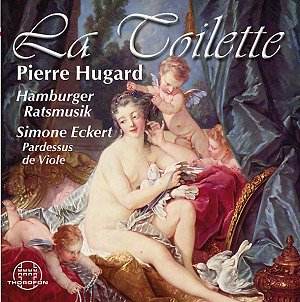This CD uniquely features music for a curious
hybrid of an instrument called the ‘Pardessus de viole’. This
flourished briefly in the mid 18th Century in the hands
of mainly female performers. The music written for it is little
known, by composers who are unknown, but how apt that a fine female
performer is making it her duty to dig it out, edit it and to
bring it all to out attention.
I must say that I am very glad to see a photograph
of the instrument in the booklet and not only because it is being
played by the lovely Simone Eckert. It is a six string (sometimes
five or even seven string) violin which is played with a bow and
held between the knees, like I suppose a mini cello. The booklet
also contains a reproduction of an 18th Century painting
with the gorgeously clad young women looking out at us whilst
playing and her somewhat lecherous looking teacher gazing across
at her.
The first music for this instrument dates from
about 1724. Today there is evidence of about 250 pieces written
for it although not all have yet been uncovered. It is tuned not
unlike a guitar, in fourths with an internal third. At first,
say around 1690, it was used for repertoire written for the flute.
By 1730 it was the chosen instrument of the upper classes for
whom at this stage the violin rather vulgarly was associated with
dance music. But soon all changed.
The greatest exponent of the instrument at the
time was one Madame Levi. By all accounts she was feted for her
musicianship in the 1740s and 1750s all across France. She bowed
"even in the highest registers, without edginess". She
enchanted the Parisian ‘Concert Spirituel’ throughout 1745. "This
is where the violin began its ascendancy over the viola da gamba
in France" to quote the excellent and extensive notes by
Simone Eckert herself.
And how beautifully she plays and with such ease
and grace of phrasing which the aforementioned Madame Levi might
have admired.
I have to say at this point that the music is
mostly mediocre but most attractive and often very tuneful, following
the format and conventions of the time to a T. The composers are
something of a mystery. The booklet briefly comments that we know
nothing about Hugard but that his music was published in the 1760s
and 1770s, i.e. after his death. There is no comment whatsoever
about Nicholas Lendormy whose music is rather short-winded and
of less interest.
The use of continuo is quite interesting in these
interpretations. Taking Hugard’s 3rd suite: the opening
‘Sarabanda’, the following ‘Le Coureur’ and first gavotte use
harpsichord and gamba but for contrast the 2nd gavotte
has baroque guitar or theorbo. Later, the first Minuet has just
gamba accompaniment but the second minuet uses the harpsichord
and so on. Different colours are applied and never a moment passes
when the listener has to constantly ‘enjoy’ one sonority.
Two ‘Pardessus de viole’ are used. The one for
the Hugard suites was made in 1748 and is of six strings. The
one used for the Lendormy is dated 1745 and is five string for
a slightly more limited range. For the latter the organ continuo
is used with theorbo. All performances are elegant, entirely in
character and utterly delightful.
The recording is very good and entirely realistic.
A very pleasurable CD
Gary Higginson

